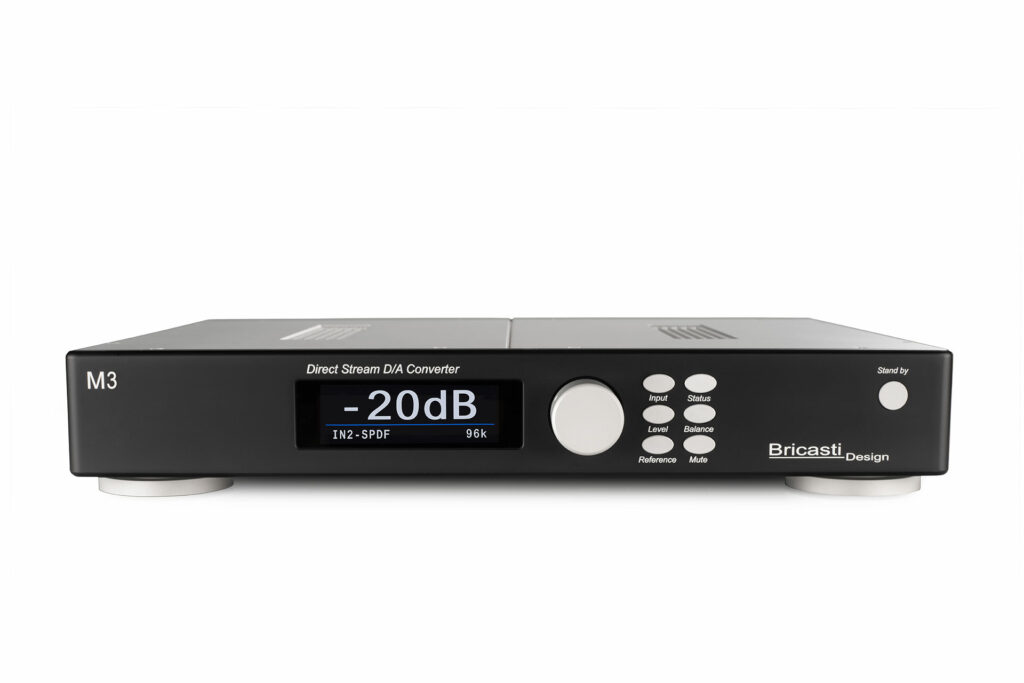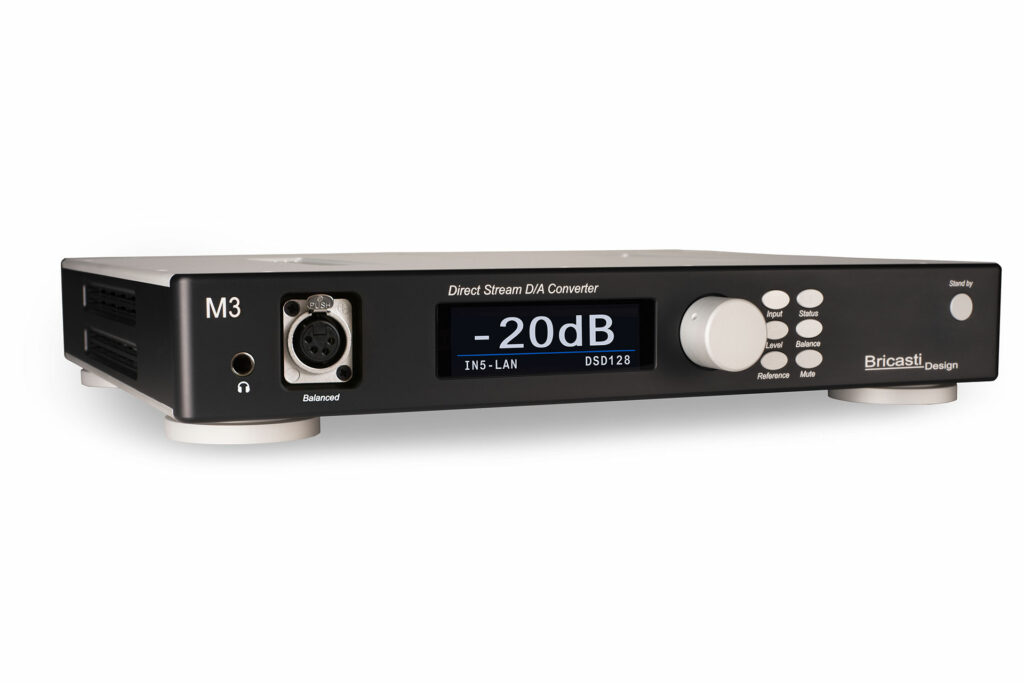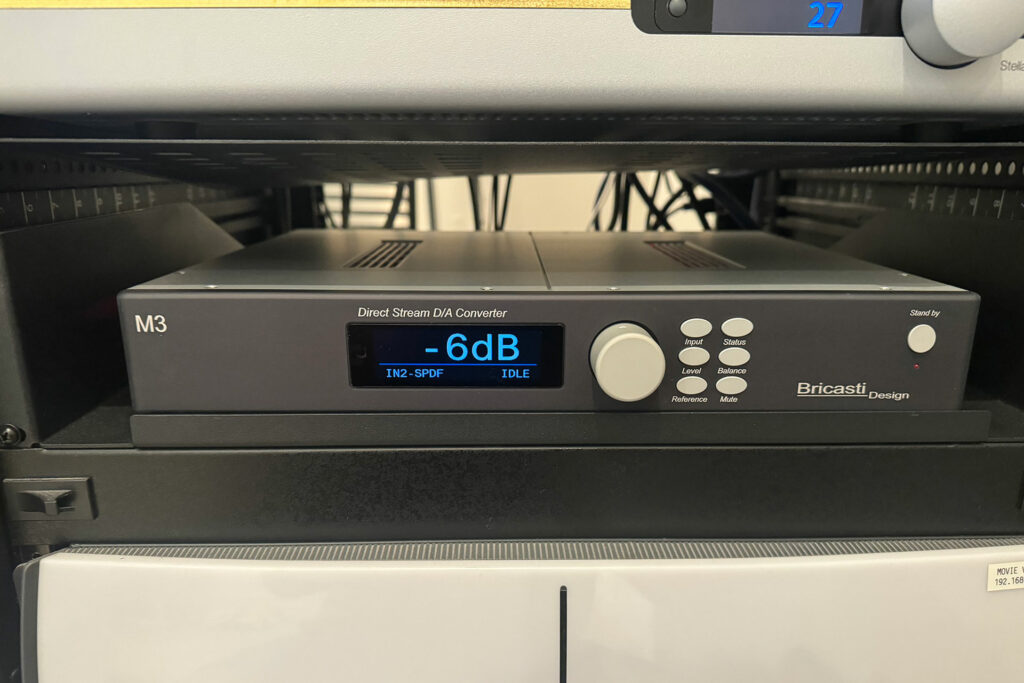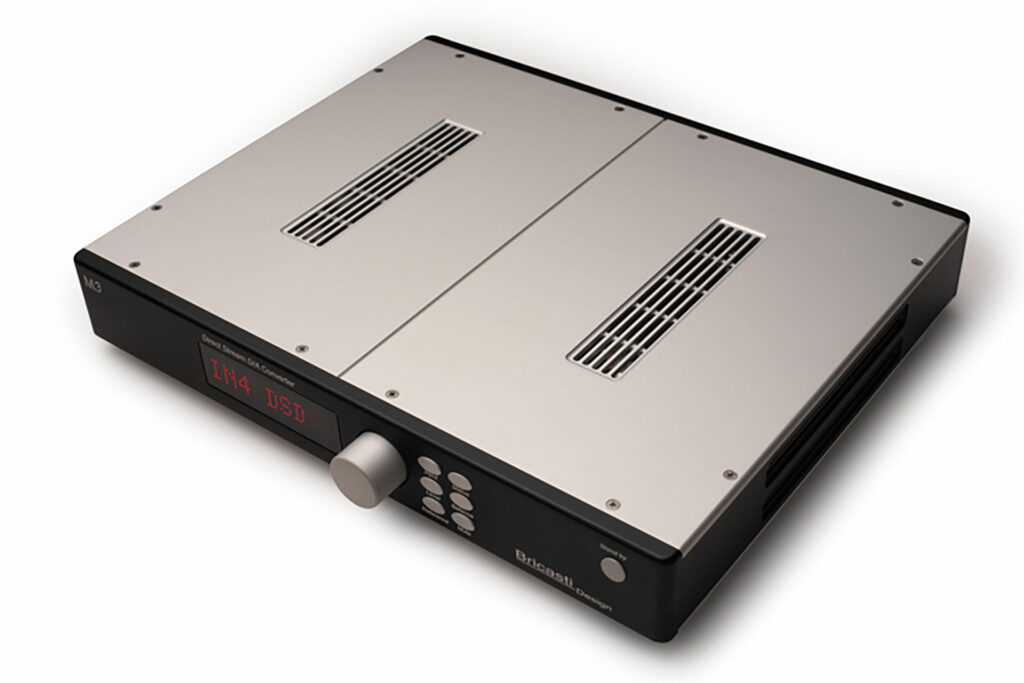The audiophile world is jam-packed with companies making uber-expensive components that cost what they cost mainly because of scarcity, esoterica and, sometimes, simple gross profiteering. Bricasti’s audiophile offerings are a breath of fresh air in this sometimes-polluted world of technological and economic bloat. Bricasti is the off-shoot of Lexicon and, a company that today makes (as Lexicon did) the world’s most trusted and used reverb unit, as well as any number of other world-class pro audio components. From the same quaint brick building in Massachusetts come some of the best-performing consumer-level audiophile products. Gone is the hype, and in its place is solid science, bleeding-edge technology, wrapped up with some serious audiophile-grade hand-craftsmanship.

The Bricasti M3 is the company’s entry-level audiophile digital to analog converter. An asking price of $6,500 (base price) makes it an expensive and very serious converter of all things zeros and ones (aka: a DAC). The chassis is slightly smaller than a traditional 17-inch-wide audiophile component, specifically in its width, but make no mistake: the build quality of this component is simply fantastic. Build costs additionally go into having multiple chipsets for both native DSD and PCM sources. More design resources go into having a badass dual power supply, which is often the special sauce that differentiates many of today’s best digital audiophile products up at these loftier prices. And that’s not where it ends. There is also a relatively affordable, standalone streaming option called the Bricasti M5 at $2,500, which allows for a high-end endpoint solution that will give you control of the DAC via any number of music management software platforms, such as Roon, JRiver and Audirvana. For $1,000, you can have that technology installed via a card right into your DAC, which would make sense for end users more than for this audio reviewer, which is just an odd circumstance. By any means and even at the entry level, $6,500 (base price) is a lot of money for a DAC these days, even if Bricasti offers bigger-better units at $10,000, like the Bricasti M1 Series II that Michael Zisserson uses as his reference, or Paul Wilson uses in the Bricasti M21 Platinum as his reference at a retail of $19,000. Does the more affordable Bricasti convert today’s digital content to an analog signal in a way that is worth the significant investment? That’s what we are here to find out…

What Makes the Bricasti M3 DAC So Special?
- When Paul Wilson got his review sample (which he ultimately bought) of the Bricasti M21 Platinum edition, he was taken back by the amount of effort that went into processing both DSD and PCM digital signals. Pure DSD audio sources aren’t vaporware, but they can sometimes be a little hard to find. However, when you do (perhaps from a physical SACD disc) the music can sound great, but its processing needs are different than that of more traditional PCM. The designers at Bricasti have options for both PCM and DSD that includes unique converters for both. The Bricasti M3 uses the ADI1955 from Analog Devices for PCM conversion. The DAC uses a custom designed chip for DSD that isn’t off-the-shelf or used in non-Bricasti products.
- Jitter is about the ugliest word that you can use in the digital audio space, and high-end digital audiophile companies work feverishly to reduce jitter to near-inaudible levels. One way that Bricasti goes about attacking this nasty digital malady is to use their DDS clocking solution. All DACs have native filtering (or upsampling) by nature. Bricasti designs their own filter to work with their clocking solution to get the best of all worlds.
- For those using all-digital audio sources, the Bricasti M3 DAC can also play the role of a stereo preamp. There is a really solid volume control on the front of the unit, and it takes all sorts if inputs, be they AES/EBU, COAX, Optical, or others.
- For $500 extra, the Bricasti M3 H offers an internal headphone option that is accessible via a ¼-inch jack or XLR port right on the front of this specific upgraded unit. I didn’t get this option, as my Bricasti wasn’t going to be anywhere near where I could listen to headphones, thus I didn’t incur the expense, but it is a nice option, as a Bricasti M3 with the headphone card is all you really need to make a kickass headphone rig, made only better by the streamer card option or the standalone Bricasti M5.
- As mentioned, Bricasti makes a streaming endpoint called the Bricasti M5, priced at $2,500, which allows you to access your music streaming services, as well as your ripped legacy music via all of the popular music management software platforms. This is often done via a laptop or an app on a tablet, but few implementations are done with this level of care and attention to detail. There is also a card-based solution for less money that is likely every bit as good (if not better) that can be installed right into your DAC for $1,000, which is a better value and is cleaner in terms of system configurations.
- There are some in the hobby who think that all DACs today “sound the same,” mainly because many use the same excellent semiconductors. I get their concern, but there is more to a good audiophile DAC than just the bleeding-edge chipset. Having spoken to many trusted digital audiophile designers: the number one impact to any digital component (analog ones too but especially digital) is the power supply. The Bricasti M3 has a robust power supply designed for the digital part of this digital to analog converter. There is also a separate power supply for the analog functionality of the Bricasti M3. While we love ourselves some Chi-Fi around here, you do get some very serious performance and design for your money when you invest into a component as serious as the Bricasti M3, and that includes a ultra-beefy dual power supply.
- The Bricasti M3 is a fully-balanced unit, meaning that it has truly discrete performance for the left and right channels. They have their own conversion and their own power supplies, as we mentioned before, in both the digital and analog domain. In lesser DAC, and with other less-pro-audio-oriented companies selling into the audiophile digital space, you might find XLR outputs, but not a truly balanced signal. With the Bricasti M3, you get the Real Deal Holyfield.
- The “Made in America” cliché get thrown around a lot in the audiophile world, and yes, the Bricasti M3 is made in Massachusetts, but you get more than just made-here pride. With any Bricasti product, you are getting hand-craftsmanship, beyond gorgeous industrial design and beefy product construction. Also expect responsive and caring customer service if you ever need it.
- Bricasti’s proven upgrade history across all of its products is about as good as any audiophile company in the marketplace today, thus a future upgrade is likely why you’d be interacting with the folks at the factory. This stuff rarely ever breaks.

Why Should You Care About the Bricasti M3 DAC?
The Bricasti M3 isn’t a DAC for every audiophile. This is a DAC for an audiophile looking to get the most he or she possibly can from their physical and increasingly streaming digital sources. If your goal with your system is to hear every possible nuance and detail that is in the master recording, then you are going to like the Bricasti M3 DAC. There are plenty of high-end audiophile DACs on the market that set out to “improve” the sound, be it through coloration or user-filtering/EQ, but the Bricasti takes the other path, which is headed to the master tape. We’ve got basically unlimited access to every recording ever made for the price of one Compact Disc today … why not hear every possible detail? That’s what the Bricasti M3 DAC aims to accomplish.
Some Things You Might Not Like About the Bricasti M3 DAC…
- The next step-up in the lineup, Bricasti M1 priced at $10,000, measures in with a full-sized chassis, meaning it’s 17 inches wide. The Bricasti M3 is not a full rack-width size, which makes it look a little less important in a traditional rack or in a professional rack, like mine from Middle Atlantic. It requires a custom rack faceplate.
- For those who “can’t handle the truth” (it is perfectly OK to internally yell like Nicholson as you read this) sonically, the Bricasti M3 isn’t going to lie. While there are some user-adjustable filters (I rarely mess with these on any DAC during reviews), this Bricasti DAC is pretty much dedicated to getting as close as possible to the source by design. If you think that you might want a tube in the output stage of your DAC, you are likely not into the Bricasti. If you want that immediate, resolute, three-dimensional sound that you get in a top recording studio, then you are barking up the right tree, my audiophile friend.
- While Lenbrook recently bought MQA, for the life of me, I haven’t been able to figure out what they plan to do with it going forward. Likely something via their BluOS that is the power behind components like the BlueSound Node ($499 – buy at Crutchfield), which we absolutely love here at FurtureAudiophile.com. With that said, and likely no real biggie, Bricasti doesn’t convert the seemingly dead format of MQA. More features and compatibility tend to always be better, but I likely can live without MQA at this stage of digital streaming.
Listening to the Bricasti M3 DAC…
In the pantheon of audiophile musical clichés, Fleetwood Mac Rumours is high on the leaderboard, but somehow was never one of my early go-to audiophile albums. Now that I listen with my wife sometimes these days, somehow this all-time classic and beautifully-recorded album gets cued up much more these days than in the past. The ultra-revealing track of “Gold Dust Woman” tends to be what I have been most drawn to when listening to different DACs and streamers. There is so much to listen to in this spacious and fantastically well-recorded track. I found myself drawn to the subtle flanger effect on what sounds to be one of the acoustic guitars, which was easier to hear with the Bricasti M3 in the loop. About three quarters of the way through the track, the song develops into an outro that is quite the extended jam. Listening to the last gasps of the track and hearing all of the vast layers of the recording was really impressive with the Bricasti M3 DAC in my system. I found myself going back for second, third and fourth servings of this track, as there was so much musical detail to hear, even if you are musically very well-acquainted with this 1970s Yacht Rock gem.
Using a local 24-96 file via the Bluesound Node, “Candela” from Buerna Vista Social Club is a jaw-droppingly good demo with the Bricasti M3 DAC in my system. The vibrance of the guitars that open the track is eye/ear-opening, but when the percussion kicks in mere seconds later, you almost feel as if you leaned in over the band as they were playing, as you can feel the opening “thud.” Later in the track, you hear the incredible polyrhythmic grooves develop. Horns float in the air with a present and realistically sharp sound. The luxury that the Bricasti M3 brings to your system is like that of being able to sonically visit Cuba. The music sounded more vibrant and realistic with the Bricasti M3 in my system.
Will the Bricasti M3 Hold Its Value?
Today’s digital products are more easily updated by software and firmware, which helps the value of any new-school audiophile DAC. In the case of the Bricasti, the professional audio crossover helps create even more demand for their products, which rarely ever hit the used market. When they do pop up, they tend to sell very quickly. The Bricasti M3 is a state-of-the-art DAC today and likely will be able to keep up with updates and upgrades over the years, better than DACs of the past. Overall, the Bricasti M3 seems like a pretty safe bet to have good resale value. In years past, I would have warned you about the slippery slope of investing your high-end audio dollars in a DAC, but in 2024, with the advancement in semiconductors and the drastically improved upgrade path (as well as Bricasti’s proven track record for upgrades), I think your audiophile investment is going to be pretty safe here.

What Is the Competition for the Bricasti M3?
The PS Audio DirectStream DAC MK2 at $7,999 is a recently reviewed contender in this space. This recently released software-upgradable DAC is a little bit pricier, but has already proven how today’s modern DACs are more easily upgradable, thus offering not just improved performance, but also better long-term value. Brian Kahn uses the older version of this DAC, and both he and Paul report that the PS Audio flagship DAC is a very capable unit that presents excellent dynamics, details and imaging. Considering that Paul was testing the PS Audio versus some of the more expensive DACs in the market – some as high as $30,000 plus – this is very high praise.
Bricasti’s M1 Series II DAC at $10,000 is also recently reviewed and is Michael Zisserson’s reference DAC (read his review). There is a lot of shared technology and (really, a lack of) house sound … if you will. The Bricasti M1 Series II is a taller and full-width component, which is oddly appealing to me for my system. It too can come with the $2,500 Bricasti M5 Network Player or the internal I2S card for $1,000, just like the Bricasti M3. Zisserson talks about the long-term product run of the M1 DAC into Series II and how it provides state of the art digital conversion, with all sorts of upgrades over nearly 14 years on the market. That’s fighting bad audiophile stereotypes, and that is a very good thing.
Meitner’s MA3 DAC is another $10,500 audiophile DAC that comes from the professional audio world (read Paul Wilson’s review), but crosses over very well to the most demanding of audiophiles who want that studio immediacy. The Meitner and the Bricasti have that sonic characteristic in common, as they both feel like you are getting closer and closer to the master tape, which can be addictive when you are talking about all of the HD options that today’s digital streaming offers. The Meitner is supportive of MQA, which feels like a bit of a dead format to me these days, but Lenbrook recently bought up that technology, so we will see. I am not sure that I would make a decision on buying a high-end DAC just because one did MQA and another did not, as it isn’t that critically important to your overall listening experience, but it is always nice to have options.
If you were looking for that Bricasti “in-the-studio” sound, but didn’t quite have the budget, the Benchmark Media DAC3 B is a great option at $1,895 (read my review here). This very small form factor high-end DAC is all pro audio all of the time, and some audiophiles find it to be a little too revealing. There are no tubes to soften the sound. There are no user filters to change the sound. What you have on your source is what you hear, and that is the right way to go about a high-end music playback system, in my take. The Benchmark Media DAC3 B brings a good amount of that resolved sound to your audio system in a very modest package at a very fair price, which is a fraction of the audiophile DAC options also included here.

Final Thoughts on the Bricasti M3 DAC…
Much attention has been given to the new companies in the world of Oligarch Audio (meaning $50,000 to $100,000-plus components), and that is well-deserved. However, by no means does even the most ultra-demanding audiophile need to make a “it-costs-as-much-as-building-a-small-hospital-in-Africa”-level investment. That’s where Bricasti comes in. Bricasti is by no means “low-cost” audiophile components, but when you put them in line with the performers that they deserve to be compared with, the brand screams VALUE-VALUE-VALUE…
The audio enthusiast who invests in a Bricasti M3 DAC is well on their way in their audiophile journey, and in for a treat. This is a component that can deliver a scary-good presentation of the all-access world of (mostly) HD music that is found from the best streaming services, be they QoBuz, Amazon Music, Tidal and so on. There are times later at night when the kids are in bed and I am listening at low levels that I hear details in recordings that I have heard hundreds (if not 1,000-plus) times that just leave me dumbfounded when playing the Bricasti M3 DAC. Yes, there are those who say “all DACs are the same,” and they are really complaining about global wealth inequality, paired with the rise in performance of today’s modern semiconductors. Do you pay to get that Nth degree of performance from the Bricasti M3 DAC? Yes, but not as much as you might pay with other DACs that aren’t always as good-sounding, made in America and with such an impressive upgrade track record. Bricasti is at the top of my A-List audiophile electronics brands, even if they aren’t the world’s most expensive, because when you let your ears do the (volume-matched) A-B listening, I think you will hear the same thing that I did, which is that this DAC can get you closer to your music. And that is the big-picture goal of any DAC in the high-end audiophile space, isn’t it?
Bricasti M3 FAQ
What makes Bricasti DACs special?
Bricasti is a company that was born when Lexicon was basically abandoned by Harman. The engineers started their own company making high end pro audio and consumer/audiophile products that are expensive but considered to be very good values too.
What is Bricasti known for?
Bricasti took the challenge of making the world’s best pro audio reverb and ran with it. Today, Bricasti is the leader in this space.
Where is Bricasti Audiophile Products Made?
The United States. Massachusetts, to be more exact.




Nice review! Since now there are “in residence” all three of the Bricasti DACs, I suspect a number of us readers of Future Audiophile reviews would love to read an article in which the M1 S2, M3, and M21 are compared side by side playing the same tracks. Might that be possible?
Lenbrook, has been, quiet in regards to MQA, I subscribe to Tidal and surprised at the amount of new releases each week continuing to come out in high resolution MQA.
If you stream Tidal from the Node you still benefit from the MQA first unfold unless there’s a way to completely bypass MQA in the Bluesound ap. It’s been so long since I’ve used the ap I don’t remember if that’s available.
Currently have the M3 on extended loan. I am interested in choral music and have been blown away by the M3’s ability to put the listener right in front of a choir in a realistic church/recording hall space. For example, there is a ‘difficult’ moment in Tallis’s Spem in alium, at about 8 minutes 30 if anyone’s interested, where with lesser DACs any choir seems to drift out of tune momentarily. They don’t, it is a failure to extract sufficient information. The M3 is the cheapest DAC that I’ve auditioned that cracks this problem (and other similar but less obvious choral recording issues). Kudos to Bricasti!
I bought (am buying) mine.
This is a killer DAC. My only issue is that I KNOW WHAT POWER SUPPLIES can do for DAC performance and the M1 has three bad ass power supplies and is a full-width unit. I might need one of them in 2025.
Also, I have the M5 endpoint for streaming and it sounds GREAT when nearly all others sound like a Bluesound etc… The M5 is good for reviewers because it is its own product but the card version that could go into an M3 or an M1 (or the M21) is MUCH BETTER in terms of simplicity and a lot less $$$. I would recommend that to anybody who doesn’t mind using Roon ($15 per month, limited streaming options but great sound)
Jerry
I agree with you Jerry. I have heard the M1 on frequent occasions (although not had one on loan as yet). From that, still rather limited, experience I would say that the differences between the M3 and M1 are small for many genres of music – the exceptions being my choral music and perhaps Scandinavian jazz. Both tend to rely on “air” in a huge soundstage for a good deal of their impact. I have not heard the M21 – and, purely on financial grounds, perhaps I should avoid doing so.
Interestingly, I feel the real strength of the M1 is drawn out by a top-quality and sonically sympathetic pre-amp. Listening to the M1 in combination with the M20 pre-amp can become a frighteningly moving and emotional experience (in a good way). However, this combination also becomes expensive in a way that the M3 on its own sidesteps – at a sonically lower but still more than very acceptable level.
As a hopefully humorous aside: my Bricasti dealer is a really good guy, but he has line-of-sight from his shop for about 300 yds down the street – and can see me coming before I get through the door. Somehow, the M1 and M20 are always playing when I visit (the Bastard!).